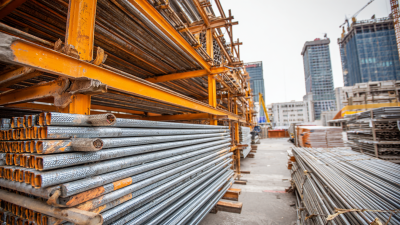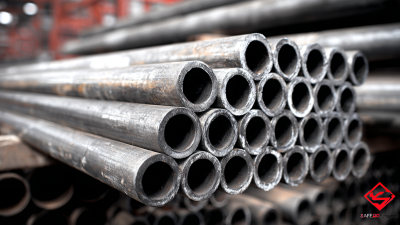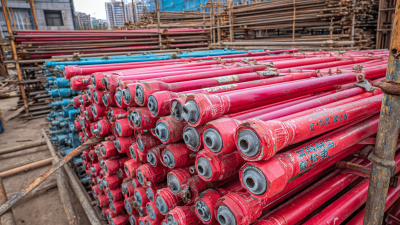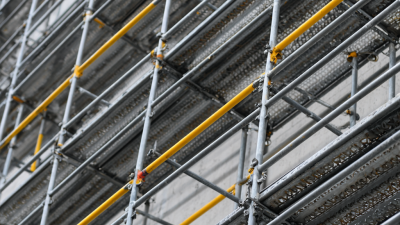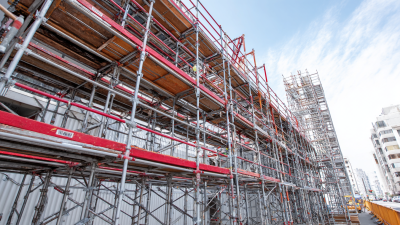 +86 18531741341
+86 18531741341
Leave Your Message
In the construction industry, the importance of safety and efficiency cannot be overstated, especially when it comes to scaffolding. Scaffolding parts are critical components that ensure the stability and safety of work platforms, significantly impacting overall project success.
According to a report by Grand View Research, the global scaffolding market size was valued at USD 46.1 billion in 2020 and is expected to grow at a compound annual growth rate (CAGR) of 6.8% from 2021 to 2028. This growth underscores the industry's recognition of the pivotal role that high-quality scaffolding parts play in reducing workplace accidents and enhancing operational efficiency.
By exploring the various essential components that make up these scaffolding systems, we can gain insights into best practices for construction projects, ultimately leading to safer job sites and improved workflow.

Scaffolding plays a pivotal role in construction safety, providing essential support and access for workers at elevated heights. It ensures that construction tasks can be performed efficiently while minimizing the risk of accidents. A well-structured scaffolding system offers stability and strength, allowing workers to navigate safely and efficiently. Furthermore, it facilitates the movement of materials and tools, which is crucial for maintaining productivity on-site.
Tips for Safe Scaffolding Use:
Scaffolding systems are vital for ensuring safety and efficiency in construction sites. A thorough understanding of the key components of scaffolding can significantly reduce the risk of accidents and facilitate smoother operations. The primary elements include standards, ledgers, transoms, and braces, each serving a specific purpose to create a stable structure. Standards are the vertical posts that bear the load, while ledgers provide horizontal support. Transoms are placed across the ledgers for added stability, and braces are essential for maintaining the scaffolding's integrity.
Tips: Always ensure that your scaffolding setup is inspected regularly for wear and tear. Proper training for workers in scaffolding assembly and safety practices can dramatically decrease the likelihood of accidents. Additionally, make sure that all components meet regulatory standards to ensure compliance and safety on-site.
As the global scaffolding market continues to grow, it becomes increasingly important for construction professionals to stay updated on the latest materials and technologies. Investing in high-quality scaffolding components not only enhances safety but also boosts overall project efficiency. Understanding the roles and applications of each element in a scaffolding system can lead to better planning and execution of construction tasks, ultimately meeting the demand of a rapidly growing industry.

Choosing the right scaffolding type is crucial for ensuring both safety and efficiency on construction projects. According to a report by the Occupational Safety and Health Administration (OSHA), improper scaffolding accounts for approximately 35% of construction-related injuries. Therefore, selecting the appropriate scaffolding can mitigate risks significantly. For instance, frame scaffolding is ideal for light to moderate tasks, while system scaffolding offers flexibility and stability for complex projects. It's essential to assess the specific needs of your project to determine which scaffolding type aligns best with your operational requirements.
**Tips:** Before making a selection, conduct a risk assessment that considers the height of the project, load requirements, and the specific environment. Additionally, consult the scaffolding manufacturer's guidelines to understand weight limits and assembly instructions.
Moreover, the use of mobile scaffolding is increasing due to its convenience for smaller tasks. A study by the National Institute for Occupational Safety and Health (NIOSH) indicates that mobile scaffolding reduces downtime and enhances productivity by 25%. However, proper training on the use of such equipment is vital to prevent accidents and ensure workers feel confident when maneuvering around the site.
**Tips:** Always ensure that mobile scaffolds are equipped with proper locks and maintained regularly to enhance safety levels.
Scaffolding plays a crucial role in ensuring safety and efficiency during construction projects. As the global scaffolding market is projected to grow from $57.14 billion in 2025 to $79.60 billion by 2032, reflecting a compound annual growth rate (CAGR) of 4.8%, the demand for proper scaffolding assembly and maintenance is more critical than ever. Implementing best practices in these areas not only enhances worker safety but also boosts productivity on construction sites.
Effective scaffolding assembly starts with thorough planning and design to meet the specific needs of each project. Using high-quality materials and rigorously following safety standards can significantly lower the risk of accidents. Regular inspections and maintenance are essential practices that ensure scaffolding systems remain structurally sound throughout their use. Maintaining a routine for checking components for any wear or damage further supports long-term operational efficiency, thus aligning with the industry's growth and safety expectations.
| Component | Material | Purpose | Best Practices | Maintenance Tips |
|---|---|---|---|---|
| Scaffolding Frame | Steel | Supports load and provides structure | Ensure proper assembly and alignment | Regularly inspect for rust and damage |
| Planks | Wood or Composite | Provides walking surface | Use non-slip surfaces when possible | Check for warping and breaks |
| Safety Guardrails | Steel or Aluminum | Prevents falls from height | Install at all open edges | Check for stability and tightness |
| Base Plates | Steel | Distributes load and stabilizes scaffolding | Ensure level placement on ground | Inspect for bending or deformation |
| Cross Braces | Steel | Provides lateral stability | Ensure proper tension during installation | Check for wear and tear |
Scaffolding plays a crucial role in the construction industry, providing essential support structure for workers and materials. However, safety regulations and guidelines governing scaffolding use are critical for ensuring a secure working environment. As the global scaffolding market is projected to grow significantly, it becomes imperative to adhere to updated health and safety rules which aim to streamline procedures for construction sites. These new regulations may allow builders to avoid the necessity for scaffolding in certain situations, thereby enhancing efficiency while maintaining safety standards.

Tips for safe scaffolding use include ensuring that all scaffolding components are inspected rigorously before use. Workers should receive adequate training on scaffolding procedures and safety practices. Additionally, regular inspections and maintenance checks should be mandated to catch any deterioration early, ensuring structural integrity and worker safety.
Moreover, clear communication of safety guidelines is vital. Employing appropriate signage and having designated safety personnel present on-site can help educate workers about potential hazards. Integrating technology, such as scaffolding design software, can also assist in planning safe and effective scaffolding setups, minimizing risks and promoting better compliance with evolving regulations.
